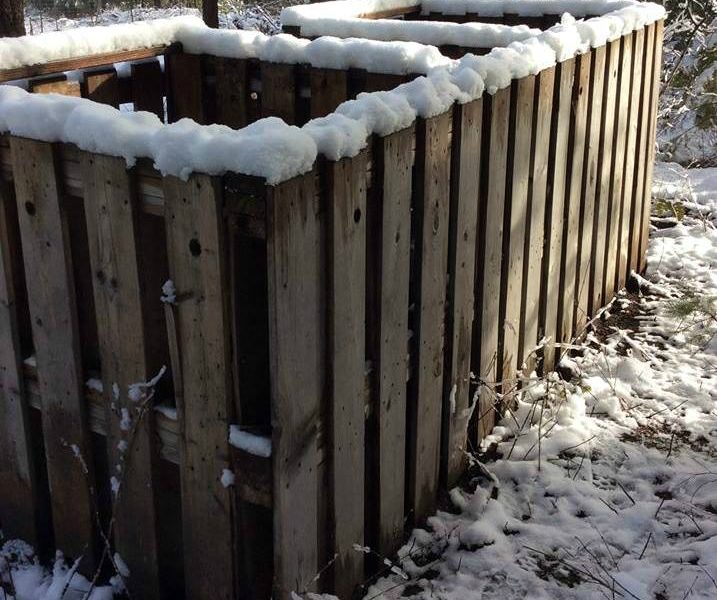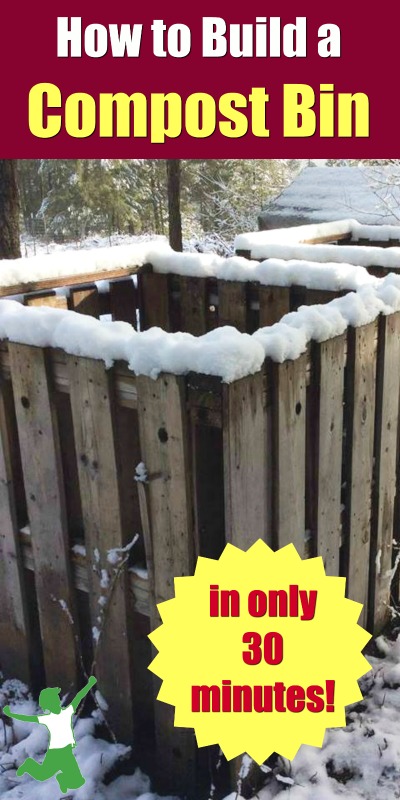Table of Contents[Hide][Show]
How to assemble your own compost bin in less than an hour with free materials that you can easily source within your community.

People are rediscovering a newfound frugality amidst the rapid economic changes and difficult realities of this new decade. Gardening is one activity that has quickly taken hold with learning the basics of composting an essential part of this process if you intend to tend your vegetables and herbs organically.
What is compost and why is it so important to organic gardening? At it’s most basic, compost is decomposed organic material. In other words, it’s a natural soil conditioner made out of anything composed of carbon, hydrogen, oxygen, and nitrogen. Think newspapers, fruit and vegetable scraps, and eggshells.
The best thing about developing a compost habit is that it makes you think about what you are buying and consuming.
If you can’t compost it, then it might not be something worth buying (or certainly putting in your body!) after all!
Developing a composting habit is beneficial not just for your garden, but also for helping each of us notice our waste and thereby extend our thoughts and habits to closing the loop as much as possible. (1)
DIY Compost Bin
Which brings me to the topic of compost bins specifically.
Most compost bins are not compostable themselves, so why spend the money to buy one? There’s nothing nastier to look at, in my opinion, than a plastic compost bin sitting in the hot, baking sun that is likely leaching toxins into the nutrient-rich, decomposing material you will be putting on your edible plants!
Why not make one yourself for next to nothing?
John Moody, author, farmer and homesteader, suggests the following materials for assembling a compost bin yourself in about 30 minutes!
Materials Needed
All you need is five wooden pallets that you can likely find quite easily at construction sites. If you wish to make your compost bin larger as shown in the picture above, feel free to get more of them!
Check with the owner of the site first, of course, to be sure that it is ok for you to take them. Most will be glad for the help hauling them away to reduce their disposal costs!
For attaching the pieces of the bin together, you will need some rope, metal wire, or leftover baling twine.
You will also need a small pile of branches, sticks, or similar yard waste material for lining the bottom.
Finally, you will need a piece of scrap PVC pipe with holes drilled in it. This is an optional material, but helpful for reducing maintenance of the compost pile over time. More on that below.
Steps for Assembling
Be sure to assemble your compost bin in the spot where you intend to leave it. This avoids the problem of having to move it when you are finished.
The area you choose should be relatively level. Also, make sure that the spot in winter isn’t shady or windswept. Try to choose a spot that will get lots of winter sun and yet is still somewhat sheltered from the wind. This is especially important the farther north you are.
Once you have your materials in the vicinity where the bin will live, you can begin the assembling process.
The first step is to vertically attach four of the pallets so that they form a square. Use rope, metal wire or baling twine to secure.
The remaining fifth pallet is for the roof. Cut it in half to provide an easy to access front edge and to also make the make a slanted roof to protect the pile from rain.
You can also make the roof from wood, metal, or some other material if you prefer. Once again, use the rope, metal wire, or leftover baling twine to attach.
Ensuring Adequate Airflow
Once the bin is assembled from the pallets, line the bottom with a layer of branches, sticks, or similar material about 4-6 inches deep. This provides additional space for your compost pile to draw in air and helps reduce the need for turning.
To provide even more airflow to facilitate the decomposition process, bury a piece of scrap PVC pipe with ¼ inch holes drilled in it in the pile. It is important that the pipe extends beyond the sides of the pile so air can freely move to the very center of the compost heap. This will keep things moving along nicely. Scrap PVC is easy to find and a very good way to reuse something that is rarely recycled!
More Information
Once you have your bin assembled, this article on how to get started with composting shares the detailed process for using leftover kitchen scraps, yard waste, and even coffee grounds to turn your garden soil into a nutrient-rich mecca for your vegetables and herbs.









Hi Sarah!
I moved into a smaller home closer to the city and would love to compost. However, my husband passed away and I have heard that rats are common with composts. I don’t know how I would handle that as I shutter at the thought of rats in my backyard. I wouldn’t want to deal with them. Too scary. Please let us know what steps to take to avoid rats. My husband built a compost at our other 2 acre yard and after a few months we started seeing rat droppings. I gave up on composting then. But now I hate throwing away so many food scraps!! Please help
Buy this inexpensive compost bin instead that keeps critters out. This is the one I have. https://amzn.to/3OmeLum
All you do is spin it. Use a scoop of rich dirt as the starter when you first put in the scraps/browns